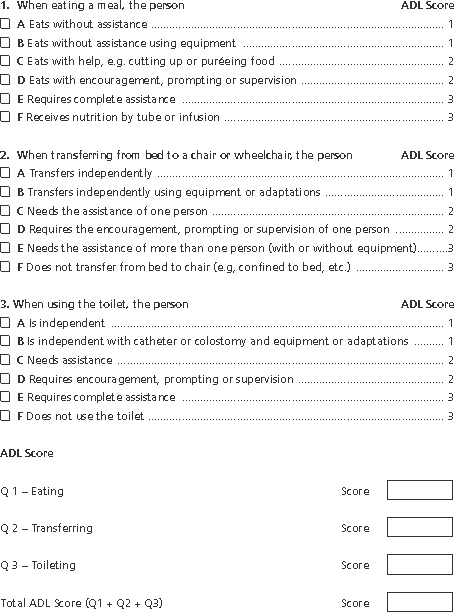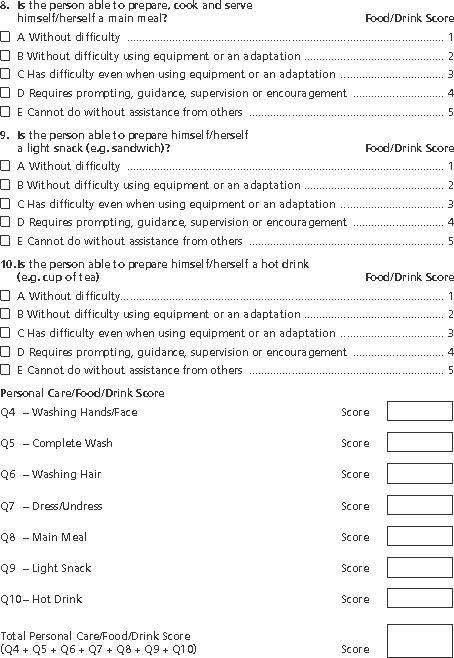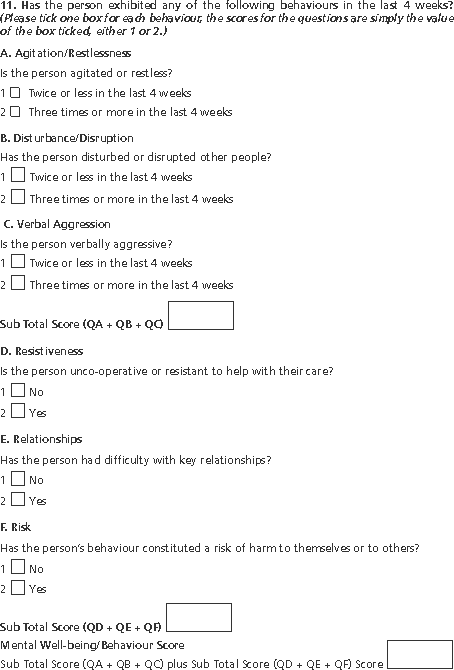Single Shared Assessment Indicator of Relative Need: Operational Guidance Users Handbook
Guidance to assist implementation of SSA-IoRN
SINGLE SHARED ASSESSMENT - INDICATOR OF RELATIVE NEED
OPERATIONAL GUIDANCE USERS' HANDBOOK
CLIENT DETAILS (Please complete in BLOCK CAPITALS) Name: ------------------------------------ Gender: M / F Date of Birth: ---- / ---- / ---- Local Authority Reference Number: --------------------- NHS Reference Number: ------------------- Date of Completion: ---- / ---- / ---- SSA-IoRN Grouping: ------- |
SINGLE SHARED ASSESSMENT - INDICATOR OF RELATIVE NEED (SSA-IORN)
General guidelines for completion of the Single Shared Assessment - Indicator of Relative Need (SSA-IoRN) Questionnaire
The "Client Details" box above is to allow you to enter appropriate identifiers for the person who is the subject of the SSA-IoRN questionnaire and score.
Answer the questions based on your most recent assessment of the person's health and social care needs drawing on mental health as well as physical needs.
If a person's needs fluctuate between two categories, select the higher of the two codes, e.g. if the person's needs fluctuate between options C and D for a particular question, select D.
Answer all questions.
GUIDELINES FOR QUESTIONS 1-3
Activities of daily living are often affected by the individual's associated mental health needs. In responding to these questions please draw on the person's mental health needs as well as their physical needs. This may be most relevant to Option D, the response related to "requires encouragement, prompting and supervision".
Q1: When eating a meal, the person . . . |
|
Select A: |
if the person eats using ordinary utensils without help, prompting or supervision, even if the meal must be prepared by someone else. |
Select B: |
if the person eats without help, prompting or supervision, but uses special or adapted utensils. |
Select C: |
if the person requires food to be cut up or its consistency to be modified in order to eat. |
Select D: |
if the person has difficulties eating a meal because of frailty, disability or lack of awareness and so requires prompting supervision and guidance. |
Select E: |
if the person requires physical assistance from another person in bringing utensils to the mouth. |
Select F: |
if, because of injury, disability or illness, the person must receive nutrition intravenously, by gastrostomy or by syringe. |
Q2: When transferring from bed to a chair or wheelchair, the person . . . |
|
This question relates to a person's ability to transfer from a position of lying down to a position of sitting in a nearby chair. |
|
Select A: |
if the person is able to transfer independently and safely without the use of any equipment or adaptations, e.g. bedrail, specially adapted chair. |
Select B: |
if the person is able to transfer independently but only with the use of equipment or adaptations, e.g. bedrail, specially adapted chair or chair specially selected (bought or supplied). |
Select C: |
if the person requires physical assistance from one person, irrespective of whether equipment is required. |
Select D: |
if the person requires encouragement, prompting or supervision, but does not require physical assistance; OR if the person uses any equipment or adaptation that requires one person to set it up or to supervise its use; OR if the person requires observation because of a risk or fear of falling; OR if the person has difficulties transferring because of frailty, disability or lack of awareness. |
Select E: |
if the person requires the physical assistance of two people, irrespective of whether equipment is required. |
Select F: |
if the person is confined to bed and/or does not sit in a chair because of illness, injury or physical disability. |
Q3: When using the toilet or commode, the person . . . |
|
This question relates to a person's ability to use the toilet/commode, that is to transfer on and off the toilet/commode, adjust clothing and maintain perineal hygiene. This question does not concern continence and bowel function (covered by question 12). But it does cover how the person manages a catheter or colostomy. It also does not concern a person's ability to get to the toilet/commode, only the ability to use it once they are there. |
|
Select A: |
if the person is able to use the toilet or commode independently without the use of any equipment or adaptations, e.g. raised toilet seat, hand rails, etc. |
Select B: |
if the person is able to use the toilet or commode independently, but only with the use of equipment or adaptations, e.g. raised toilet seat, hand rails. This includes those persons who independently manage a catheter or colostomy. |
Select C: |
if the person requires minimal physical assistance from one person to use the toilet or commode, but performs the majority of the tasks himself/herself, e.g. if the person needs a small amount of assistance in transferring on and off the toilet, or in adjusting clothing. |
Select D: |
if the person requires encouragement, prompting or supervision to use the toilet or commode because of a lack of motivation, fear of falling, confusion or memory loss, but does not require physical assistance; OR if the person uses any equipment or adaptation that requires one person either to set it up or to supervise its use; OR if the person has difficulties using the toilet because of frailty, disability or lack of awareness. |
Select E: |
if the person requires assistance with all aspects of using the toilet. |
Select F: |
if the person does not use the toilet or alternative receptacle because of physical disability or injury, or because he/she requires assistance to manage their catheter or colostomy. |
Activities of Daily Living and Mobility
GUIDELINES FOR QUESTIONS 4-7
Personal care tasks are often affected by the individual's associated mental health needs. In responding to these questions please draw on the person's mental health needs as well as their physical needs. This may be most relevant to Option D, the response related to "requires encouragement, prompting and supervision".
Q4: Is the person able to wash his/her face and hands?
This question relates to a person's ability to maintain good personal hygiene by washing his/her face and hands. It includes the ability to turn taps on and off, and adjust water temperature to avoid scalding. (See below for guidance on each option.)
Q5: Is the person able to give himself/herself a complete wash, bath or a shower?
This question relates to a person's ability to wash in a bath or shower (including getting into or out of the bath or shower) or give himself/herself a complete wash by other means. It includes the ability to turn taps on, adjust water temperature to avoid scalding, and turn taps off again to prevent flooding. (See below for guidance on each option.)
Q6: Is the person able to wash his/her own hair?
This question relates to a person's ability to wash his/her own hair, using soap or shampoo, irrespective of whether they do so in the shower/bath or over a sink. (See below for guidance on each option.)
Q7: Is the person able to dress/undress himself/herself?
This question relates to a person's ability to put on, take off, secure and unfasten all garments in a manner appropriate for the weather. It also includes, the ability to adjust and fasten garments following use of the toilet, and as appropriate, the ability to put on and take off any braces, artificial limbs or other surgical appliances. (See below for guidance on each option.)
For all questions 4-7:
Select A: |
if the person requires no help, prompting or supervision from another person to perform the task AND does not require equipment or adaptations to do so. |
Select B: |
if the person requires no help, prompting or supervision from another person to perform the task, but uses equipment or adaptations to do so. |
Select C: |
if the person is able to perform the task, but because of frailty, disability or recent injury, finds it difficult to do so, even when using equipment or adaptations; OR if the person has difficulty with one aspect of the task (e.g. putting on socks and shoes, getting into a bath), even if they have no difficulty with another aspect (e.g. putting on trousers or shirt, washing themselves once in the bath). |
Select D: |
if the person: |
|
|
Choose this option if the person generally does not require physical assistance with the task, but nevertheless (for whatever reason) often requires someone to be present in order to perform it themselves. |
|
Select E: |
if the person: |
|
|
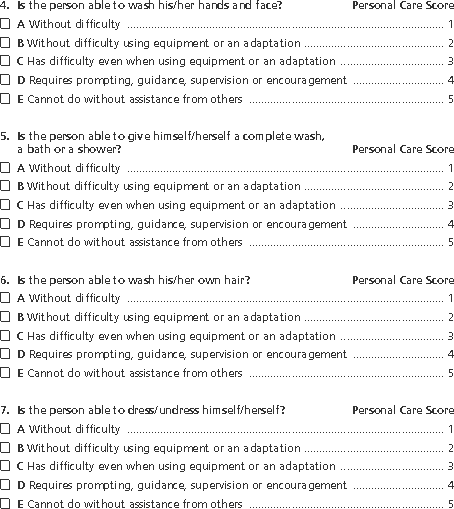
continue and score on page 7
GUIDLINES FOR QUESTIONS 8-10
Food/drink preparation tasks are often affected by the individual's associated mental health needs. In responding to these questions please consider and draw on the person's mental health needs as well as their physical needs. This may be most relevant to Option D, the response related to "requires encouragement, prompting and supervision".
Q8: Is the person able to prepare, cook and serve himself/herself a main meal?
This question relates to a person's ability to prepare a hot meal for himself/herself. It includes the ability to operate any appliances required (microwave, cooker, oven), and to obtain appropriate nutrition. (See below for guidance, on each option.)
Q9: Is the person able to prepare himself/herself a light snack (e.g. sandwich)?
This question relates to a person's ability to prepare himself/herself a snack between mealtimes. No cooking or use of electrical equipment, e.g. cooker/grill required. (See below for guidance on each option.)
Q10: Is the person able to prepare himself/herself a hot drink (e.g. cup of tea)?
This question relates to a person's ability to boil a kettle, and pour the water into a teapot or coffee pot and cup, without injury or scalding. (See below for guidance on each option.)
For all questions 8-10:
Select A: |
if the person requires no assistance, prompting or supervision from another person to perform the task AND does not require equipment or adaptations to do so. |
Select B: |
if the person requires no assistance, prompting or supervision from another person to perform the task, but uses equipment or adaptations to do so. |
Select C: |
if the person is able to perform the task, but because of frailty, disability or recent injury, finds it difficult to do so, even when using equipment or adaptations. |
Select D: |
if the person: |
|
|
Select E: |
if the person: |
|
|
Food/Drink Preparation
GUIDELINES FOR QUESTION 11
Q11: Has the person exhibited any of the following behaviours in the last 4 weeks?
When answering question 11, please consider the possible impact of any of these behaviours on the person's activities of daily living, personal care and food/drink preparation needs. This is to ensure the person's needs as a whole are reflected in each section, and a recognition that there may be overlaps across sections.
This question relates to the behavioural signs and symptoms of mental health problems such as dementia (or other forms of cognitive impairment), anxiety, depression, schizophrenia, etc. It also covers behavioural problems which may result from alcohol or drug dependencies, or acquired brain injury. Tick one box for each behaviour to indicate how often the behaviour has occurred in the last 4 weeks. Focus only on the last 4 weeks, even if the person has displayed a certain behaviour frequently in the past, but not in the last 4 weeks. It is recognised that the successful treatment and management of certain mental illnesses may result in a reduction in the frequency of some behavioural problems.
For each behaviour A-C, indicate how often it has occurred in the last 4 weeks. If it has not occurred or has occurred twice or less, select option 1 - "twice or less". If option 1 selected, when assigning score, score 1. Choose option 2 - "three times or more" - even if the behaviour has occurred irregularly in the last 4 weeks, or if it has occurred only in certain contexts (the examples below detail where behaviours may occur in certain contexts). If option 2 selected, when assigning score, score 2.
For each behaviour D-F, indicate whether or not it has occurred at all in the last 4 weeks. Choose option 1 - "No", if it has not occurred at all in the last 4 weeks. If option 1 selected, when assigning score, score 1. Choose option 2, "Yes" - even if the behaviour has occurred three times or more in the last 4 weeks, or if it has occurred only in certain contexts (the examples below detail where behaviours may occur in certain contexts). If option 2 selected, when assigning score, score 2.
Answer the questions exactly as they are stated. The responses to the questions will clearly be subjective in nature. However, in all cases, they should be based on the professional assessment of the assessing practitioner. If a person presents a particular behaviour, please indicate this by ticking the appropriate box. In some cases, the presentation of a behaviour may not particularly pose a problem to the person or others; indicate the frequency with which the behaviour is presented, irrespective of whether it poses a problem to the person or to others.
The following examples are provided to reduce any ambiguity in the questions.
Qstn A: |
Agitation/Restlessness - Agitation/Restlessness may include, for example, pacing, unable to sit for a period of time or unable to settle to a particular task. |
Qstn B: |
Disturbance/Distruption - Disturbance/Distruption may include, for example, a person waking a spouse/relative during the night or a person making excessive contact with family/neighbours for no reason. |
Qstn C: |
Verbal aggression - Verbal aggression may be directed towards other people, animals or objects. |
Qstn D: |
Resistiveness - Resistiveness may include not only a person's active refusal to co-operate with their care, but also to situations where a person apparently agrees to receive care, but then is consistently out when the care worker arrives, etc. |
Qstn E: |
Relationships - Key relationships are considered to be those which are significant to the person, or which are necessary for their care. They may include individuals such as a spouse, a daughter or son, a carer, a member of the social work services team, a nurse or a doctor, for example. |
Qstn F: |
Risk - Risk of harm might include, for example, dangers relating to accidental explosion, fire, poisoning (including medication, food or carbon monoxide poisoning), disorientation out with the home, self neglect leading to reduced activity, abuse (e.g. emotional, verbal, physical, financial, sexual), etc. |
Mental Well-being and Behaviour
GUIDELINES FOR QUESTION 12
Q12: Does the person require any of the following interventions or treatments relating to bowel management?
These questions relate to the person's need for assistance with bowel management for both day or night. Please tick one box. If the person requires no intervention or treatments for bowel management, select 1.
Question 12 relates to a person's ability to maintain a healthy bowel function. It includes the care required to prevent both constipation and faecal incontinence. If a person is incontinent only in certain situations or circumstances, indicate how often this occurs.
Select A: |
if the person is fully continent, does not require, or rarely requires assistance from another person OR if the person is independent with pads or other continence aids, equipment or adaptation OR if the person requires a prompt to take the oral medication on a daily basis to maintain healthy bowel function such as laxatives, forming agents, e.g. methylcellulose or antimotility drugs, e.g. codeine phosphase OR if the person requires prompting, supervision or assistance to maintain a healthy bowel function or to manage problems relating to faecal incontinence, but on average, less than once a week. |
Select B: |
if the person requires prompting, supervision or assistance to maintain a healthy bowel function or to manage problems relating to faecal incontinence, on average, more than once a week OR if the person requires assistance at least once a week during the day or night for stoma care. |
Bowel Management
12. Does the person require any of the following interventions or treatments relating to bowel management? (Please tick one box)
Provision of assistance, guidance, prompting or supervision to maintain bowel function
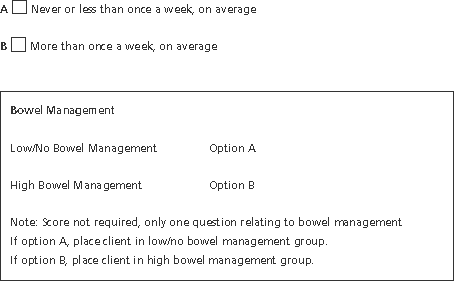
Assigning Client to SSA-IoRN Grouping
The purpose of completing the SSA-IoRN is to allow practitioners to assign their client to a SSA-IoRN grouping. There are 2 steps to this process: Step 1 is to allocate the ADL group (low, medium or high). Step 2 works out the SSA-IoRN group - this is done by following the instructions in one of the boxes below.
Please refer to the diagram on page 13 when allocating SSA-IoRN grouping.
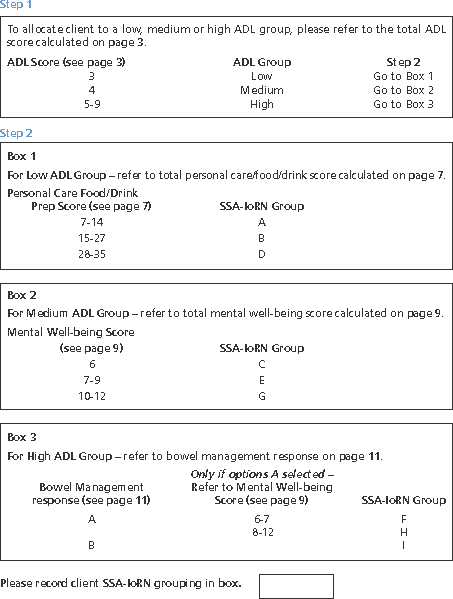
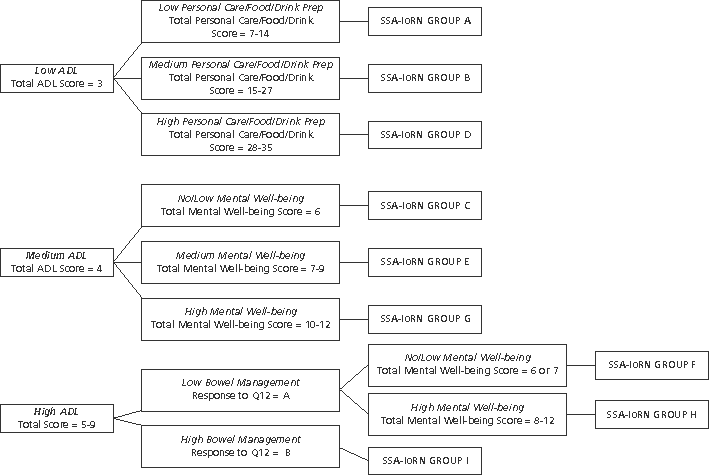
There is a problem
Thanks for your feedback
